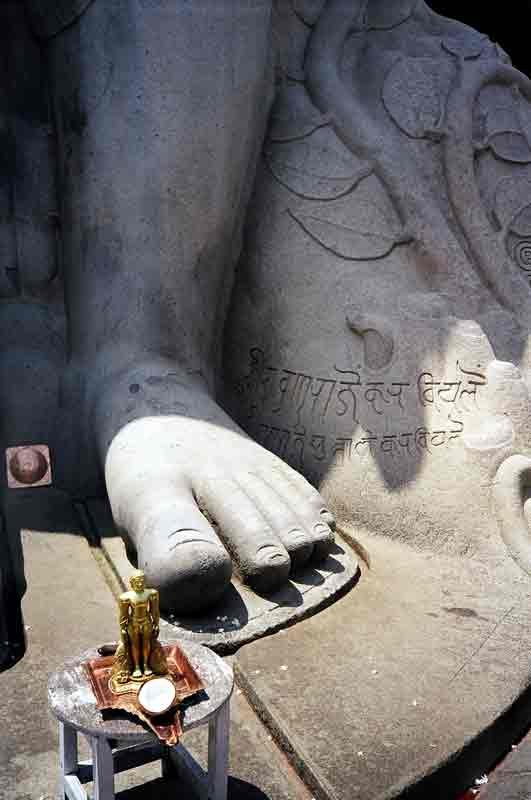IndragiriThe statue of Gomateshwara
The following is an extract from the travel book A River of Life: Travels through Modern India.

The town of Sravanabelagola is busier than its size warrants, swelled, like many such towns, by a steady influx of pilgrims. Its ramshackle homes, a haphazard cluster of terracotta roofed structures, lies nestled between the two outcrops of rock which define the northern and southern borders of the town, Indragiri on one side, Chandragiri on the other. It is the hill of Indragiri, and its 800 foot statue of the Jain saint Gomateshwara at the summit, that make Sravanabelagola a centre of pilgrimage.
As I pad barefoot up to the summit - the usual rule, no chappals allowed - I am reminded of the town of Gwalior, near Delhi, with its larger-than-life carvings in the cliff face, like a race of supermen who had sprouted fully-formed from the rock. There is only a single figure here, representing Gomateshwara, son of the first Jain tirthankara Adinatha. At 17 metres in height, the statue is on a par with the figures at Gwalior, although unlike those it was sculpted from a free-standing block of rock, the largest such sculpture in the Subcontinent. It has also, like most other monuments of the South and unlike many of those of the North, been protected from the bigotry of marauding Muslims and Mughals, with the result that, unlike the mighty men of Gwalior, Gomateshwara is handsomely endowed both with facial features and genitalia.

Big-shouldered, wide-hipped, it is an imposing figure. Coconuts have been set at its feet. They look like poppy seeds next to the big big toe. All Jain images are shown meditating either in the lotus position or body-upright, always naked to reflect their renunciation of worldly ways. Gomateshwara is shown standing. He had meditated in a forest following an almost murderous encounter with his brother which had awakened him to the brutality inherent in all men, and he had stood in the forest so long that vines had grown and twined themselves about his arms and legs, ants had built nests around his feet, all details which are recreated here, in stone.
According to Jain wisdom, we live in an age of decreasing purity, in consequence of which the stature of man is also decreasing. In the time of Adinatha and his son, Gomateshwara, men were giants; hence the often grand scale of depictions of Jain saints and tirthankaras, the crossing makers of the Jain religion, also called jinas, from the Hindi jainas, meaning victors, saviours who have succeeded in crossing over life's stream and making a path for others to follow. As well as physical stature, life spans are also said to be decreasing with the "turning of the wheel" of this base age of ours. In addition to being fabled giants, Adinatha and his son are said to have lived millions of years. Mahavira, the 24th and last tirthankara and founder of the Jain religion - a contemporary of Gautama Buddha, who preached austerity as the way to enlightenment instead of the Buddha's more lenient Middle Way between luxury and asceticism - had had a considerably more human life span, a mere seventy two years.
Temples etc.
A River of Life
Read on...
Read the next article about the neighbouring hill of Chandragiri.
I gaze out over the land beyond the hill. It is bare and rocky, dull but in a pleasant way, a sandy brown streak of colour dotted by dhak and eucalyptus trees and spiked by palms. A lake just below the horizon is reduced to a puddle of water by the distance. There are no people on the far side of the hill, no villages, towns, or roads. Even today, Sravanabelagola is a remote and lonely spot, the perfect retreat for Jain monks.
Go back...
Read the previous article about the Sri Meenakshi Temple at Madurai.
The Sri Meenakshi Temple on Chitrai Street is the commercial and devotional focus of the city of Madurai, lying at the heart of its lotus plan. Being in the Southern or "Dravidian" style, the most arresting feature about it is, naturally enough, the soaring gopurams over its cardinal entrances: brash and impressive, beautifully colourful, covered all over with sculpture.

Available for purchase now
Sheldon's account of his overland travels around India, A River of Life, is available for purchase now. Buy the e-book from Amazon.com or Amazon.co.uk, or the paperback from Amazon.com or Amazon.co.uk (also available in other countries, search Amazon for more information).
The first instalment, A River of Life, Book 1: Travels in the North, is available separately (e-book format only) via Amazon.co.uk or Amazon.com. The second instalment, A River of Life, Book 2: A Tour of the South, is available via Amazon.co.uk or Amazon.com.
